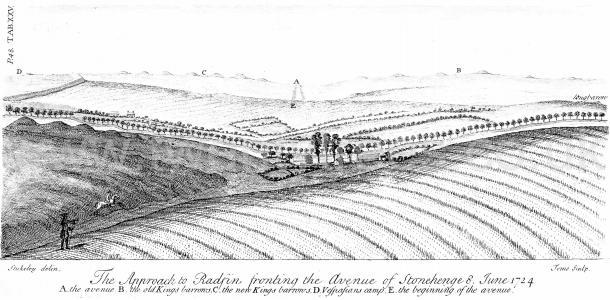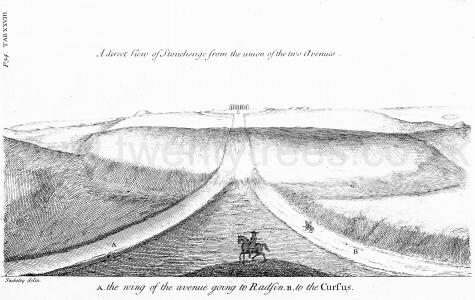Europe, British Isles, South-West England, Wiltshire, Amesbury [Map]
Amesbury, Wiltshire is in Wiltshire.
Anglo-Saxon Chronicle. 994. This year died Archbishop Siric: and Elfric, Bishop of Wiltshire, was chosen on Easter-day, at Amesbury [Map], by King Ethelred (age 28) and all his council. This year came Anlaf and Sweyne to London, on the Nativity of St. Mary, with four and ninety-ships. And they closely besieged the city, and would fain have set it on fire; but they sustained more harm and evil than they ever supposed that any citizens could inflict on them. The holy mother of God on that day in her mercy considered the citizens, and ridded them of their enemies. Thence they advanced, and wrought the greatest evil that ever any army could do, in burning and plundering and manslaughter, not only on the sea-coast in Essex, but in Kent and in Sussex and in Hampshire. Next they took horse, and rode as wide as they would, and committed unspeakable evil. Then resolved the king and his council to send to them, and offer them tribute and provision, on condition that they desisted from plunder. The terms they accepted; and the whole army came to Southampton, Hampshire [Map], and there fixed their winter-quarters; where they were fed by all the subjects of the West-Saxon kingdom. And they gave them 16,000 pounds in money. Then sent the king; after King Anlaf Bishop Elfeah and Alderman Ethelwerd;48 and, hostages being left with the ships, they led Anlaf with great pomp to the king at Andover, Hampshire [Map]. And King Ethelred (age 28) received him at episcopal hands, and honoured him with royal presents. In return Anlaf promised, as he also performed, that he never again would come in a hostile manner to England.
Note 48. This was probably the veteran historian of that name, who was killed in the severe encounter with the Danes at Alton (Aethelingadene) in the year 1001.
In 1187 Ela of Salisbury 3rd Countess of Salisbury was born to William of Salisbury 2nd Earl Salisbury (age 37) and Eleanor Vitre Countess of Salisbury (age 29) in Amesbury, Wiltshire [Map].
On 21 Mar 1316 Isabel Verdun Baroness Ferrers Groby was born to Theobald Verdun 2nd Lord Verdun (age 37) and Elizabeth Clare Lady Verdun (age 20) at Amesbury, Wiltshire [Map]. She a great granddaughter of King Edward "Longshanks" I of England.

The Wiltshire River Avon is formed from the confluence of the River Avon West, Wiltshire and River Avon East, Wiltshire one kilometre before Upavon, Wiltshire [Map] after which it flows broadly south past East Chisenbury, Wiltshire [Map], Enford, Wiltshire [Map], Fifield, Wiltshire [Map], Fittleton, Wiltshire [Map], Netheravon, Wiltshire [Map], Figheldean, Wiltshire [Map], Durrington Walls, around Amesbury, Wiltshire [Map] and past Amesbury Abbey, Wiltshire [Map], Wilsford, Wiltshire [Map], Great Durnford, Wiltshire [Map], Middle Woodford, Wiltshire [Map], Little Durnford, Wiltshire [Map], Old Sarum [Map], Stratford sub Castle, Wiltshire [Map], through Salisbury where it is joined by the River Nadder
After Salisbury the Wiltshire River Avon flows south in multiple channels past Longford Castle, Wiltshire [Map], after which it is joined by the River Eble, then Charlton-All-Saints, Wiltshire [Map], Downton, Wiltshire [Map], Breamore, Hampshire [Map], Burgate, Hampshire [Map], Fordingbridge, Hampshire [Map], Bickton, Hampshire [Map], Ibsley, Hampshire [Map], Ringwood, Hampshire [Map], Bistern, Hampshire [Map], Sopley, Hampshire [Map], Avon, Dorset [Map] and Christchurch, Dorset [Map] before reaching Christchurch Harbour where it joins the English Channel.
Europe, British Isles, South-West England, Wiltshire, Boscombe Down Amesbury
2300BC. Boscombe Bowmen [Map] is the remains of a shared burial of around 2300BC found at Boscombe Down Amesbury. The grave contained seven burials: three children, a teenager and three men. The teenager and men appear to have been related. The eldest man was buried in a crouched position with the bones of the others scattered around him, and their skulls resting at his feet. Several flint arrowheads, a boar tusk, flint tools and eight Beaker Ware vessels were found found with the remains. Lead isotope analysis indicates the men grew up in South Wales or the Lake District. The remains are on display at Salisbury and South Wiltshire Museum [Map].
Europe, British Isles, South-West England, Wiltshire, Amesbury, Haradon aka Telegraph Hill [Map]![]()
Haradon aka Telegraph Hill [Map]. Somewhat speculatively identified as William Stukeley's Haradon Hill from his sketch of 06 Aug 1723. At 116m Haradon Hill is high point that provides a view overlooking the entire Stonehenge landscape.
Stonehenge by William Stukeley. In order to have a just notion of this avenue, it is necessary to go to the neighbouring height of Haradon hill [Map], on the other side the river. The largest barrow there, which I call Hara's and which probably gave name to the hill, is in the line of the avenue; the ford of Radfin lying between, as we see in the last Plate. I stood upon this hill May 11. 1724. during the total eclipse of the sun, of which I gave an account in my Itinerarium. Here is a most noble view of the work and country about Stonehenge. Whoever is upon the spot cannot fail of a great pleasure in it; especially if the fun be low, either after rising or before setting. For by that means the barrows, the only ornaments of these plains, become very visible, the ground beyond them being illuminated by the suns flaunting rays. You fee as far as Clay-hill beyond Warminster 20 miles off. You fee the spot of ground on the hill, whereon stands Vespasians camp [Map], where I conjecture the avenue to Stonehenge began, and where there was a facellum, as we conceive. From hence to that spot a valley leads very commodiously to Radfin [Map], where the original ford was.
Europe, British Isles, South-West England, Wiltshire, Amesbury, North Tidworth
On 28 Mar 1691 Dean Thomas Pierce (age 69) died at North Tidworth, Wiltshire where he had an estate.
Europe, British Isles, South-West England, Wiltshire, Amesbury, Ratfyn [Map]![]()
Ratfyn, Wiltshire [Map] is believed to have been the location of the ford across the Wiltshire River Avon of the Harrow Way?
Stonehenge by William Stukeley. Table XXV. The Approach to Radfyn [Map] fronting the Avenue of Stonehenge. 8 Jun 1724. A. the avenue [Map]. B. the old Kings Barrows. C. the new Kings barrows. D. Vespasians camp [Map]. E. the beginnings of the avenue.

Stonehenge by William Stukeley. This Radfin-farm [Map] seems to retain its Celtic name: meaning a ford or passage for chariots, the old way of carriage here used. Rhedeg currere, rhedegfain curfitare, in Irijh reathaini. Fin in the old Irish, is white. It regards the chalky road which went up from the ford. 'Tis a pretty place, seated in a flexure of the river, which from hence seems to bend its arms both ways, to embrace the beginning of the avenue. The place is very warm, sheltered from all winds, and especially from the north. I am persuaded it was originally a seat of an Archdruid or Druid. See Mr. Poland discoursing of the Druids houses, p. III. The nuns of Ambresbury too had a chapel there. The ford is now quite disused, because of the bridge by the town's end; and the road of it is foreclosed by hedgerows of pastures on both sides the lane, leading northwards from Ambresbury to north Wiltshire. This road lying between Radfin and the beginning of Stonehenge avenue, is sweetly adorned with viorna. We are supposed now to stand on the tumulus of Hara, an old Irish royal name, and possibly the king who was coadjutor in founding Stonehenge, who lived, it's likely, in the eastern part of Wiltshire: for which reason they directed the avenue this way.
Stonehenge by William Stukeley. Table XXVIII. A direct View of Stonehenge from the union of the two Avenues. A the wing of the avenue going to Radfin [Map]. B. to the Cursus.

Stonehenge by William Stukeley. In order to have a just notion of this avenue, it is necessary to go to the neighbouring height of Haradon hill [Map], on the other side the river. The largest barrow there, which I call Hara's and which probably gave name to the hill, is in the line of the avenue; the ford of Radfin lying between, as we see in the last Plate. I stood upon this hill May 11. 1724. during the total eclipse of the sun, of which I gave an account in my Itinerarium. Here is a most noble view of the work and country about Stonehenge. Whoever is upon the spot cannot fail of a great pleasure in it; especially if the fun be low, either after rising or before setting. For by that means the barrows, the only ornaments of these plains, become very visible, the ground beyond them being illuminated by the suns flaunting rays. You fee as far as Clay-hill beyond Warminster 20 miles off. You fee the spot of ground on the hill, whereon stands Vespasians camp [Map], where I conjecture the avenue to Stonehenge began, and where there was a facellum, as we conceive. From hence to that spot a valley leads very commodiously to Radfin [Map], where the original ford was.